
Children’s diseases associated with sun deprivation. by Marc Sorenson, EdD
Children’s diseases that are associated with sun deprivation are legion. So, how do I know this? Because my last five blogs discussed this topic, and I’m a long way from finishing the theme.
To subject our children to sun deprivation is child abuse. It results in either lifelong or temporary children’s diseases.
So, the first of the children’s diseases discussed this week will be acute lower respiratory infections (ALRI). In addition, the second will be attention deficit hyperactivity disorder (ADHD).
ALRI are a leading cause of sickness and mortality both in children and adults worldwide. Furthermore, ALRI are not uniformly defined and this may hamper a true appreciation of their importance. Also, from an epidemiological point of view, the definition of acute lower respiratory infections includes other diseases. The most noteworthy of these diseases are acute bronchitis and bronchiolitis, influenza and pneumonia. The NCBI also states that acute respiratory infections, and particularly lower respiratory tract infections are deadly. Another fact is that these diseases are the leading cause of death among children under five years of age. Especially relevant is that they are estimated to be responsible for between 1.9 million and 2.2 million childhood deaths globally.
Studies regarding children’s diseases indicate that sun exposure has protective effects, whether due to vitamin D production or another factor.
First of all, in one study, children placed outside in sunlight were less than half as likely to suffer ALRI. Another investigation on sunlight compared vitamin D levels and sun exposure habits in children with and without ALRI. And, there was virtually no difference in vitamin D levels between the sick and healthy groups. Yet, those children who had a higher percentage of the body exposed to sunlight were less likely to have ALRI. Therefore, this reinforces the fact that sun exposure has preventive effects beyond vitamin D for children’s diseases.
ADHD (attention deficit hyperactivity disorder) is another of the disheartening children’s diseases.
ADHD is the most prevalent of mental disorders in children. And, it causes significant problems with executive functions (e.g. attentional control and inhibitory control). In addition, it causes attention deficits, hyperactivity, or impulsiveness not appropriate for a person’s age. Thus, it is certainly another of the important children’s diseases. Also, researchers have found that sun exposure correlates to a decreased risk of ADHD. The investigators assessed the relationship between ADHD prevalence and sun intensity in various nations and in US states. As a result, they found a close association between low sunlight intensity and the prevalence of ADHD. Another finding was that it explained 34%–57% of the variance in ADHD prevalence, with high sunlight intensity having a preventive effect.
It seems like the advice to deprive our children of sun exposure, in order to a prevent melanoma, is disastrous. Do we want to increase the chance of ALRI, ADHD or other children’s diseases we have already discussed? In conclusion, let’s love our children and be sure that they receive plenty of regular, non-burning sun exposure. And for more information, read the book, Embrace the Sun.
Happy sunning!
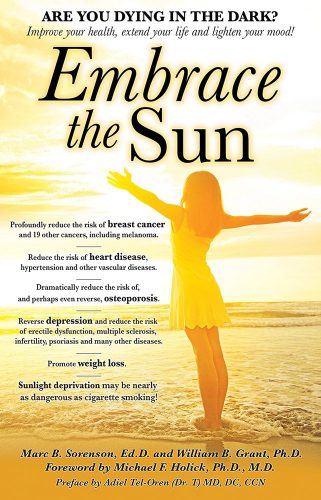
Childhood diseases prevented by Sunlight. by Marc Sorenson, EdD
Childhood diseases are directly associated with sun deprivation: Therefore, childhood death and disability can be due to lack of sun exposure!

Childhood diseases and disorders that are prevented by sun exposure have been discussed on many of my recent blogs. Our children are becoming ill due to our neglect. We must insist that they (or in some cases their mothers) play outside each day while eschewing their electronic devices. So, let’s now discuss a few more childhood diseases that are associate with sun deprivation. First of all, there is a 61% increase in death risk among children born to women with low 25(OH) D levels. Since sun exposure on skin is the main source of that photoproduct (vitamin D), the mothers lack sufficient sun exposure. Therefore, they do not furnish the necessary vitamin D to deliver a healthy baby. Furthermore, they are unlikely to bring their babies out in the sun after birth.
It is probably important at this point to mention a vital point. In many cases, vitamin D is exceptionally important. And in other cases, vitamin D may have little to do with the childhood diseases being considered. Since sun exposure leads to vitamin D production, vitamin D levels may simply be a surrogate measurement for sun exposure. Therefore, it may be other photoproducts of sun exposure that are creating some of the health benefits. And what are some of those other photoproducts that may reduce childhood diseases?
- Serotonin, which is one of the body’s natural “uppers”
- Endorphin, another feel-good hormone
- Dopamine, which affects learning and behavior and may help schizophrenia, to attention disorders, and cognitive reasoning
- Brain-derived neurotropic factor (BDNF), which is essential for nerve growth
- Nitric oxide, which reduces blood pressure and may help prevent heart disease.
Whenever vitamin D deficiency is blamed for childhood diseases, sun-exposure deficiency—which causes vitamin D deficiency—is the actual culprit.
Here are three more childhood diseases that are associated with low sunlight exposure:
Eczema: a disease that can be a part of childhood diseases
First of all, a study of children aged 0-17 years showed sun exposure was associated with lessened prevalence of eczema. Hence, children in the highest fourth of exposure were 20% less likely to experience eczema. This is one of the common childhood diseases.
Lack of bone mineralization and size: another of the childhood diseases.
An English investigation, involving 7,000 children, found bone size was positively related to sun exposure of mothers during pregnancies. Researchers conducted another study on children with on poor bone mineral density that predicted fractures. All of them had a significant increase in bone density because of a sun-exposure program that lasted a year. It is also most noteworthy that none of these children had a fracture after the start of the sun-exposure program.
Food allergy emergency: Another of the childhood diseases
Research from Boston states that children younger than 5 years, who were born in fall or winter (times of low sun exposure) had bad outcomes. They had about 50% increase in the risk of emergency room visits for food allergies. That is, compared with children born in spring or summer. Hence, the authors suggested this finding was related to differences in UVB (sun) exposure during their mother’s pregnancies.
In subsequent blogs we will discuss more childhood diseases that are triggered by sun deprivation. In the meantime find more information at sunlightinstitute.org and read the book, Embrace the Sun.
Happy sunning!
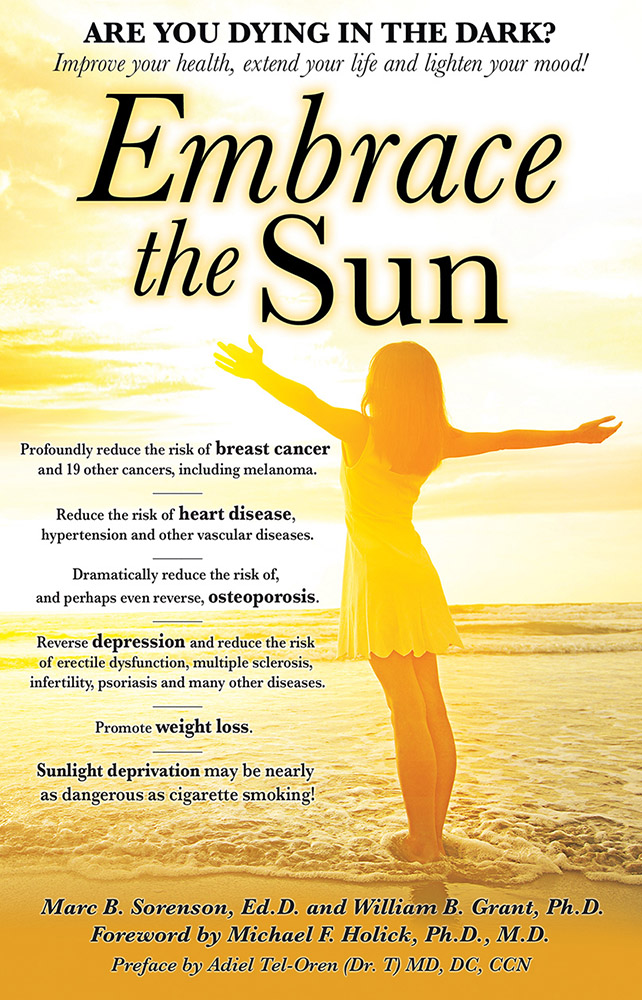
Protect our children with sunlight. By Marc Sorenson, Ed.D
Protect our children and we save the world.


And, we can’t protect our children unless we provide them with sufficient sunlight. This is part three of a series concerned with protecting our children from sun deprivation and the Powers of Darkness. Consequently, we have already covered the dangers of sun deprivation on the childhood diseases of melanoma, myopia, asthma, and AIDS. So, please read the previous two blogs on http://sunlightinstitute.org/ and let’s keep the anti-sun demons at bay!
Protect our children with sunlight and reduce the risk of acute lower respiratory infections (ALRI).
First of all, the definition of ALRI usually includes acute bronchitis and bronchiolitis, influenza and pneumonia. ALRI is a leading cause of sickness and mortality both in children and adults worldwide.[1] According to the World Health Organization, 20% of all deaths in children 5 years old or younger are due to ALRI,[2] and several studies indicate that sun exposure has a protective effect against the disease.
How well does sunlight protect our children from ALRI?
So, in one piece of research, children who were placed outside in the sun, uncovered, were less than half as likely to suffer ALRI. Also, those who had the lowest levels of vitamin D were ten times more likely to contract this infection than those with the highest levels. Therefore, we can obviously protect our children from ALRI with the sun. So there is no sane reason to deprive our children of sunlight. Also, an investigation compared the vitamin D levels and sun exposure habits in children with and without ALRI. In conclusion, there was virtually no difference in vitamin D levels between the sick and healthy groups. Yet, those children who had a higher percentage of the body exposed to sunlight were less likely to have ALRI. This reinforces the fact that sun exposure has many healing effects beyond its ability to stimulate the production of vitamin D.
Can sunlight help protect our children from dental cavities?
It seems like the answer is yes. One finding showed a direct correlation between hours of available sun per year and the number of dental caries (cavities) in Caucasian boys 12 to 14 years of age: And in geographic areas with less than 2,200 hours of available sunlight, there were, on average, 486 cavities per-year in each group of 100 boys.
In areas where there were 3,000 hours of sunlight, there were only 290 cavities per year per hundred boys. The frequency of cavities was also higher in winter than in summer months.[3] This indicates that sunlight played a big part in reducing cavities.
As a result of this information, we build on the truth that children’s optimal health suffers when they have insufficient sunlight. For more information, read the new book, Embrace the Sun.
Happy sunning!

[1] http://www.erswhitebook.org/chapters/acute-lower-respiratory-infections.
[2] WHO statistics. Accessed 8, 2010. http://www.who.int/fch/depts/cah/resp_infections/en/
[3] McBeath, E. The role of vitamin D in control of dental caries in children. J Nutr 1938;15:547.
Save the children with sunlight. by Marc Sorenson, EdD

Save the children is a refrain heard throughout the world, and a great refrain it is. It truly is time to save the children. There is so much child abuse and so many childhood health disasters that it is a burden we cannot ignore. It is especially relevant that our children are addicted to noxious foods and sedentary lives. And, the sun robbery they experience is equally harmful. This article is the first of several discussing the necessity for sun exposure if we are to save the children.
Save the children from myopia.
First of all, myopia (nearsightedness) among children is pandemic and increasing at an alarming rate. And, researchers demonstrated as early as 2008 that the lowest myopia risk was among those with highest outdoor activity. Some have surmised that the key ingredient that could save the children from myopia was exercise. But, the researchers refuted that idea because they also demonstrated that indoor exercise did not reduce myopia risk.
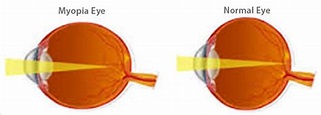
Most noteworthy, the same research showed the prevalence of myopia among Chinese children living in Singapore was 29.1%. Furthermore, the prevalence among Chinese children living in Sydney, Australia was only 3.3%. Is this because the Sydney children spent about 13.8 hours per week outdoors compared to 3.1 hours in Singapore? Hence, the children who spent most of their lives indoors had 9.5 times the risk of developing myopia! So adults in Sidney who let their kids play in the sun, certainly knew how to save them from myopia.
How much sunshine does it take?

Children under six should spend three hours daily in sunshine, according to other researchers who want to save them. So what could be a more natural? Just be sure the children do not burn.
Consequently, the next time someone tells you that it is not good for children to play outside, tell them the facts. Outdoor activity in the sunlight is absolutely necessary to save them from myopia. For more information: sunlightinstitute.org, and read my book, Embrace the Sun.

Flesh-eating Bacteria and genitals. The drug companies strike again. By Marc Sorenson, EdD.
What is flesh-eating bacteria of the genitals?

Flesh-eating bacteria of the genitals is a rare, alarming disease associated with a class of type-two diabetes drugs (SGLT2 inhibitors). While many people take these drugs, only a few are unfortunate enough to contract the disease. So the publication, Medical Express, states, “one day you notice pain, redness and a foul odor in your genital area.” As much as I wanted to include an image of this disease, it was too nauseating for me to do it.
Do flesh-eating bacteria really eat flesh?
Of course, bacteria infect, and they don’t eat flesh. The term flesh-eating bacteria is probably used as a description for the rapidity of the infection.
There is a better way to stop diabetes than using a drug that could cause flesh-eating bacteria.
First of all, the real tragedy of this finding is that type-two diabetes is the easiest of all degenerative diseases to reverse. And, I might say, the easiest to prevent. So we don’t need a diabetes drug that could cause flesh-eating bacteria of the genitals. In the health resort that my wife, Vicki and I founded, we had spectacular results. Two-thirds of diabetic clients ceased all medications in about 11.6 days (and no flesh eating bacteria occurred). And if the clients stayed for a month, 85% were off all medication. Furthermore, most of the remaining 15% dramatically reduced their medication. The people became well due to proper nutrition, exercise and plenty of sunshine. So, knowing that, why would the medical community not use that simple method? The answer: there is no money to be made by pharmaceuticals when diabetics heal themselves because of changed lifestyles.
Is flesh-eating bacteria a new phenomenon?
Flesh-eating bacteria have been around for some time, but until the advent of these drugs, diabetes has not been involved. The “old” flesh-eating bacteria disease was called necrotizing fasciitis–another rarity due to strep bacteria. It is most noteworthy that the disease is most common in seasons of low sun exposure, with the highest incidence in winter. Probably, sun-stimulated vitamin D produces the cathelicidins (an antimicrobial peptide) necessary to keep the disease at bay during the summer.
A great new book.
In our book, Embrace the Sun, Dr. William Grant and I make a calculation. For each death caused by diseases associated with sun exposure, there are 328 deaths because of diseases associated with sun deprivation. And two of the diseases associated with sun deprivation are type-two diabetes and necrotizing fasciitis.
The message for preventing diabetes stopping the use of flesh-eating drugs is this: Stop eating junk foods and start getting some regular, non-burning sun exposure (without noxious sunscreens). Happy sunning!For more information on the marvels of sun exposure, visit http://sunlightinstitute.org/ Also read the new book, Embrace the Sun.

Kidney cancer and sunlight. By Marc Sorenson, EdD
Kidney cancer is positively associated with vitamin D supplements—maybe.
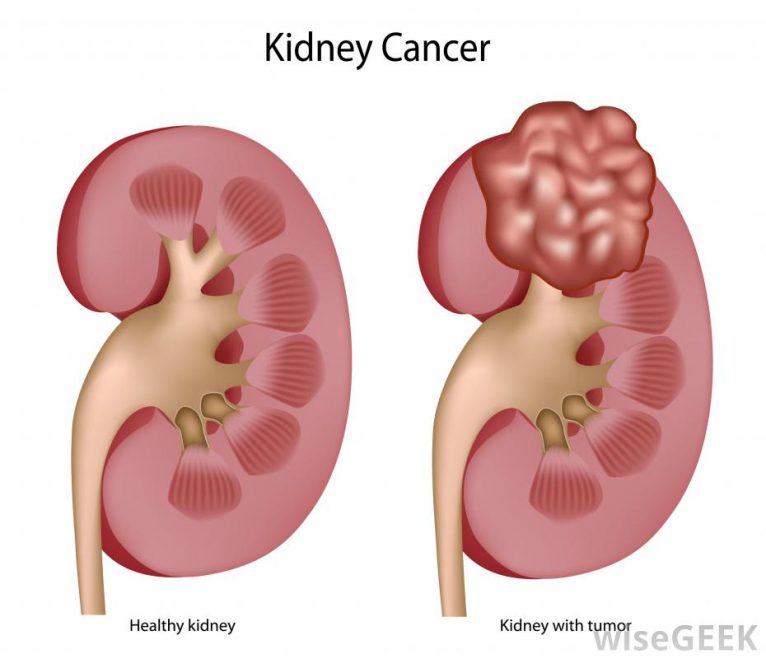
There are 62,700 cases of kidney cancer and 14,240 deaths annually. Kidney cancer can be a killer, and maybe sunlight exposure can reduce its risk. And, it is not vitamin D and kidney cancer, but sunlight and kidney cancer, which really piques my interest. I am an advocate of vitamin D and health if vitamin D is obtained from sun exposure to the skin. So today, I was alerted to an article that D supplements—in one subject—was associated with kidney cancer. Consequently, my mind immediately travelled to the book I wrote with William Grant: Embrace the sun.
Kidney cancer studies compiled in Embrace the Sun:
We referenced several studies, which determined that sun exposure reduced many cancers, including kidney cancer, by 35% to 42%.[1] Kidney cancer mortality rates were also found to be strongly inversely correlated with sunshine doses in Dr. Grant’s studies.[2], [3]
Kidney cancer, sunlight and women
Recent research has also demonstrated that high levels of sun exposure in women significantly reduces kidney cancer.[4] Those women with the highest fourth of sun exposure showed a 33% reduction in risk. Interestingly, the data was adjusted for vitamin D intake, and the results still showed sun exposure to have a stand-alone protective influence on kidney cancer—another indication that sun exposure has protective effects beyond the benefits of vitamin D.
Other studies on kidney cancer, using different designs, have produced comparable effects: A study of Swedish construction workers showed a significant 30% decrease in risk among men with the highest sun exposure.
Why would vitamin D supplementation be a negative for kidney cancer?
So why would vitamin D supplementation have deleterious effects on kidney cancer, when sunlight appears to have such salubrious effects on kidney cancer? First of all, one person does not research make! Secondly, the doses of vitamin D were also quite high, 8,000-12-000 IU per day. Thirdly, the vitamin was not produced by the sun, meaning that the subject’s kidney were not protected by the whole gamut of sun-stimulated photoproducts such as nitric oxide, serotonin, endorphin, dopamine, brain-derived neurotropic factor (BDNF) and many others that we have yet to discover.
Summary:
All of the sun’s photoproducts have a place in the choir. Sun exposure should be used holistically. I have been beating that drum for some time. One cannot take a vitamin D pill and hope to achieve all the health benefits of whole-sun exposure.

It is also imperative to understand that toxic levels of
vitamin D are not produced by sun. The body self-regulates vitamin D levels
when they are produced in the skin by sun exposure. Sunlight is vital to human
life. Be sure to get your share of non-burning, safe sunlight and protect
yourself from kidney cancer. And while you are sunning, be sure to read the book,
Embrace
the Sun. And for more information on Kidney cancer, sunlight and
vitamin D visit Sunlight
institute.

[1] Tuohimaa P, Pukkala E, Scélo G, Olsen JH, Brewster DH, Hemminki K, Tracey E, Weiderpass E, Kliewer EV, Pompe-Kirn V, McBride ML, Martos C, Chia KS, Tonita JM, Jonasson JG, Boffetta P, Brennan P. Does solar exposure, as indicated by the non-melanoma skin cancers, protect from solid cancers: vitamin D as a possible explanation. Eur J Cancer 2007;43(11):1701-12
[2] Grant WB. An estimate of premature cancer mortality in the US due to inadequate doses of solar ultraviolet-B radiation. Cancer. 2002 Mar 15;94(6):1867-75.
[3] Grant WB, Garland CF. The association of solar ultraviolet B (UVB) with reducing risk of cancer: multifactorial ecologic analysis of geographic variation in age-adjusted cancer mortality rates. Anticancer Res. 2006 Jul-Aug;26(4A):2687-99.
[4] Karami S, Colt JS, Stewart PA, Schwartz K, Davis FG, Ruterbusch JJ, Chow WH, Wacholder S, Graubard BI, Purdue MP, Moore LE. Short Report: A case-control study of occupational sun exposure and renal cancer risk. Int J Cancer. 2015 Oct 27.
The great outdoors, sun exposure and health. By Marc Sorenson, EdD.
The great outdoors, because of the sun, is magnificent! The UVB rays have returned to the sunshine in Saint George, Utah, and I have taken full advantage of them, sunbathing daily at midday. But In addition, the great outdoors furnishes so many advantages beyond our life-giving sunlight. Or does it? First of all, sunlight directly effects human health through stimulating the skin to produce photoproducts. Hence, such life-saving products as vitamin D, serotonin, endorphin, nitric oxide, dopamine and brain-derived neurotropic factor (BDNF) are increased. Furthermore, none of the other attributes of the great outdoors, such as the greenery and animal life, would be possible without the sun.
Recent research on the great outdoors
A recent study analyzed most of the health research that has been done on the benefits of the great outdoors.[1] The title of the research was: The health benefits of the great outdoors: A systematic review and meta-analysis of greenspace exposure and health outcomes. It was an analysis of 143 studies. The researchers showed impressive results from spending time in the great outdoors, especially the green great outdoors, known as greenspace.
Health expectations derived from enjoying the great outdoors:
- A reduction in diastolic blood pressure
- Decreased preterm birth risk
- A reduction in type two diabetes risk
- Decreased all-cause mortality
- A reduced risk of small size for gestational age
- Decreased risk of cardiovascular mortality
- An increased incidence of self-reported health
- Decreased incidence of stroke, hypertension, dyslipidaemia, asthma, and coronary heart disease
- Decreased risk of neurological and cancer-related outcomes and respiratory mortality
- Reduced negative emotions and fatigue
In addition, the authors noted that groups who exercised in the great outdoors had better health results. Indoor exercisers had results that were less than the outdoor exercisers. Thus, the great outdoors groups had significantly improved blood pressure, heart rate, fat percentage, BMI, cholesterol, depression and physical functioning.
While being in the great outdoors is exceptionally important to health, so is sunlight exposure. It is especially relevant that benefits enumerated for outdoor exposure are identical to those for regular, non-burning sun exposure. My new book, Embrace the Sun, delineates those healthful effects. It also cites research that indicates sun deprivation is as dangerous a cigarette smoking.[1]
Summary: Combine sun exposure with the great outdoors.
I opine that both safe sun exposure and exposure to the
great outdoors, are vital to health. So, it is best not to neglect either. Happy sunning!
[1] Lindqvist PG, Epstein E, Nielsen K, Landin-Olsson M, Ingvar C, Olsson H. Avoidance of sun exposure as a risk factor for major causes of death: a competing risk analysis of the Melanoma in Southern Sweden cohort. J Intern Med. 2016 Oct;280(4):375-87.
[1] Caoimhe Twohig-Bennett, Andy Jones. The health benefits of the great outdoors: A systematic review and meta-analysis of greenspace exposure and health outcomes. Environmental Research 166 (2018) 628–637.
[2] Lindqvist PG, Epstein E, Nielsen K, Landin-Olsson M, Ingvar C, Olsson H. Avoidance of sun exposure as a risk factor for major causes of death: a competing risk analysis of the Melanoma in Southern Sweden cohort. J Intern Med. 2016 Oct;280(4):375-87.
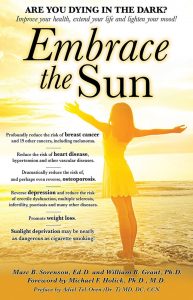 Parkinson’s disease prevented by sunlight. By Marc Sorenson, EdD
Parkinson’s disease prevented by sunlight. By Marc Sorenson, EdD
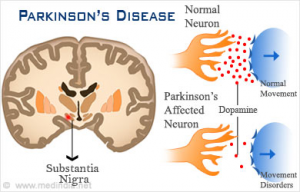 Parkinson’s disease is a common nerve disease, and it is caused by deterioration of brain cells that produce dopamine. It is characterized by tremors, muscle rigidity, shuffling gait, slow speech, and a mask-like facial expression. In addition, even simple movements may become difficult for the person suffering from the disease. And, the disease is a killer that takes the lives of 14,593 per year.[1] So how do we prevent it? In this blog, I will explain the disease, show what the research says about sunlight, and make recommendations for prevention.
Parkinson’s disease is a common nerve disease, and it is caused by deterioration of brain cells that produce dopamine. It is characterized by tremors, muscle rigidity, shuffling gait, slow speech, and a mask-like facial expression. In addition, even simple movements may become difficult for the person suffering from the disease. And, the disease is a killer that takes the lives of 14,593 per year.[1] So how do we prevent it? In this blog, I will explain the disease, show what the research says about sunlight, and make recommendations for prevention.
Research points out that Sun exposure is the key to prevention of Parkinson’s disease.
Several studies have shown that there is a close association between sunlight exposure, blood 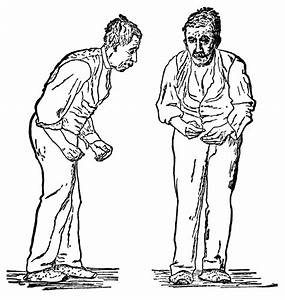 vitamin D levels and Parkinson’s. First of all, one paper showed that when vitamin D levels are low, there is a tripling of the risk.[2] Another study from China demonstrated that persons with highest levels of blood vitamin D had a 48% decrease in risk. And, that same research demonstrated that those receiving the greatest sun exposure had about a 47% decrease in risk.[3] So, based on those findings, one might think that vitamin D supplements could prevent the disease. Yet, that thought is erroneous. Sun exposure is the direct key for preventing this debilitating disease.
vitamin D levels and Parkinson’s. First of all, one paper showed that when vitamin D levels are low, there is a tripling of the risk.[2] Another study from China demonstrated that persons with highest levels of blood vitamin D had a 48% decrease in risk. And, that same research demonstrated that those receiving the greatest sun exposure had about a 47% decrease in risk.[3] So, based on those findings, one might think that vitamin D supplements could prevent the disease. Yet, that thought is erroneous. Sun exposure is the direct key for preventing this debilitating disease.
Vitamin D supplements do not stop Parkinson’s, so how can that be?
Recent research, a systematic review and meta-analysis, is most noteworthy. And it explains this interesting paradox.[4] It showed that sun exposure was significantly associated with a reduced risk of Parkinson’s. Especially relevant is the fact that those persons with plenty of sun exposure had only 1/50 the risk of Parkinson’s. That is an astounding figure! However, although vitamin D supplements were effective in raising vitamin D levels, they had no significant benefits for Parkinson’s disease.
Vitamin D and sun exposure are not the same.
While sun exposure and supplements both raise vitamin D levels, supplements are no help to Parkinson’s sufferers. Hence, we must look beyond vitamin D for an answer. Sun exposure leads to the production of vitamin D, but it also leads to the production of dopamine. Dopamine, as previously mentioned, is a vital chemical for the brain as regards Parkinson’s. Vitamin D is a marvelous, vital photoproduct and is due to sun exposure. It is vital for human health. However, it appears that vitamin D does nothing for Parkinson’s. Most of all, we must remember that sun exposure produces many essential photoproducts beyond vitamin D.
Vitamin D blood levels, in the case of Parkinson’s and some other diseases, are simply surrogate measurements of sun exposure. We simply cannot substitute a vitamin D pill for sun exposure and expect to reap all the benefits of sunlight. The “holistic” sun will never be supplanted by a capsule. The sun stimulates the production of vitamin D, dopamine, nitric oxide, serotonin, endorphins, brain-derived neurotropic factor (BDNF) and other photoproducts. And, all of these photoproducts play their roles in human health. For some diseases, vitamin D is vital for prevention. In others such as Parkinson’s, it is just along for the ride.
The takeaway regarding sun exposure and Parkinson’s.
To help prevent this disease, be sure to obtain plenty of non-burning sunlight. And In lieu of that, when there is no sunlight available, use a low-pressure sunbed (tanning bed) in a salon. Always remember not to burn. For more information, read my new book, Embrace the Sun, available at Amazon: https://www.amazon.com/Embrace-Sun-Marc-B-Sorenson/dp/069207600X 
Happy sunning!
[1] ttps://www.rightdiagnosis.com/p/parkinsons_disease/deaths.htm
[2] Knekt P, Kilkkinen A, Rissanen H, Marniemi J, Sääksjärvi K, Heliövaara M. Serum vitamin D and the risk of Parkinson disease. Arch Neurol. 2010 Jul;67(7):808-11.
[3] Wang J, Yang D, Yu Y, Shao G. Wang Q. Vitamin D and Sunlight Exposure in Newly-Diagnosed Parkinson’s Disease. Nutrients 2016;8:142.
[4] Zhou Z, Zhou R, Zhang Z, Li K. The Association between Vitamin D Status, Vitamin D Supplementation, Sunlight Exposure, and Parkinson’s disease: A Systematic Review and Meta-Analysis. Med Sci Monit. 2019 Jan 23;25:666-674.
Antioxidants: power against skin cancer. Marc Sorenson, EdD
Antioxidants can quench (eliminate) free radicals.
Antioxidants are popular as supplements, and they are found many foods, but especially in fruits and vegetables. Because they are critical to good nutrition, let’s first consider what they do to a prevent cancer. First of all, what are they? They are substances that eliminate free-radical atoms and molecules. These radicals are formed by combining oxygen with stable atoms, hence the term “oxidation.” Therefore, we must also understand the free radical in order to understand the antioxidant’s importance.
Antioxidants and the notorious free radical 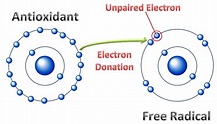
A free radical is a highly unstable atom capable of independent existence and having at least one unpaired electron in its outer shell.[1] So, when an atom loses an electron, it becomes unstable in an attempt to reestablish balance. Because this atom “craves” to have its balance restored, it will “steal” an electron from another atom to achieve stability. Therefore, the atom from which the electron is stolen becomes another free radical. The first atom now becomes stable because it has snatched an electron. Consequently, however, the atom from which the electron is snatched becomes another free radical.
So this process repeats innumerable times.[2] And this chain reaction cannot cease until another substance, with an extra electron to “give away,” steps in. That substance finally furnishes the electron that produces stability. That substance, of course, is an antioxidant.  Thus, antioxidants can furnish electrons to stabilize free radicals without causing damage. Hence, they are like the hero who gives his life for the team and then passes on.
Thus, antioxidants can furnish electrons to stabilize free radicals without causing damage. Hence, they are like the hero who gives his life for the team and then passes on.
Oxygen in free-radical formation
As mentioned, the process of free-radical formation is known as oxidation, because free radicals are usually formed due to oxygen molecules, which are unstable. This is possible because oxygen easily combines with other substances. Oxygen gives us life, but its byproducts, if not controlled, can quickly end life. As an iron pipe rusts, it is because it succumbing to the free-radical attack of oxidation. When anything burns, free radicals form. Due to oxidation, a single cigarette creates about one quadrillion free-radical attacks.[3] Cooking creates massive quantities of free radicals. Breathing, heart beat and exercise also create oxidation. It is most noteworthy to understand that without antioxidants, our metabolic processes would shortly kill us because of oxidation.
Antioxidants and skin cancer
Oxidation damages DNA, and unchecked, it causes cancer. Therefore, the fact that smoking kills so many people attests to an obvious reality. Because smokers have insufficient levels of antioxidants to handle the free-radical load, they succumb to cancer. In fact, smoking is a major cause of non-melanoma skin cancers (NMSC); the greater the number of cigarettes smoked, the greater is the risk of skin cancer.[4] So, how important are antioxidants to cancer prevention, especially non-melanoma skin cancer? The research on antioxidants and skin cancer expatiates on this subject.[5]
More important research on antioxidants and Basal Cell Carcinoma (BCC)
The research just mentioned tells us that NMSC accounts for more that half of all diagnoses of cancer. And basal cell skin cancer (BCC) accounts for 70-80% of skin tumors. So, the researchers set out to determine the influence of antioxidants on NMSC. They tested 84 individuals and divided them into two groups: 1. a control group of healthy people, and 2. a case group of those who were undergoing surgery for BCC. In addition, they measured the blood of each group for free-radical markers, and then they compared the two groups. Also, they assessed the usual dietary intake of the subjects. As a result they discovered that the case group had significantly higher markers of oxidative stress compared with controls. While these results were impressive, there were other interesting results:
Other results regarding antioxidants
- Especially relevant was that antioxidants from foods were more pronounced in the control group. It seems like antioxidants from food must have been protective against BCC. Why? Because the intake of foods containing antioxidants showed their influence in reducing oxidative stress. Most of all, vitamins A and E were more prevalent among the non-diseased subjects.
- Also, the dietary concentrations of antioxidants minerals such as zinc, copper and selenium in the case group were significantly lower than healthy controls.
The power of fruits and veggies. 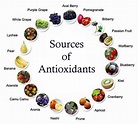
Vegetables and fruits rich in antioxidants are protective against various diseases. We know this due to a plethora of research and observations. This research adds more information indicating that we should stop blaming the sun for skin cancer and clean up our diets. See sunlightinstitute.org for more information on skin cancer and nutrition, And to learn more about the benefits of sunlight, read my book, Embrace the Sun, available at Amazon. https://www.amazon.com/Embrace-Sun-Marc-B-Sorenson/dp/069207600X 
Also, search sunlightinstitute.org: http://sunlightinstitute.org/protect-skin-nutrition-sun-exposure/
Happy sunning!
[1] Karlsson, J. Introduction to nutraology and radical formation. In: Antioxidants and Exercise. Illinois: Human Kinetics Press 1997:1-143. Goldfarb, A. et al. Nutritional antioxidants as therapeutic and preventive modalities in exercise-induced muscle damage. Can. J. Appl. Physiol 1999;24:249-266.
[2] Goldfarb, A. et al. Nutritional antioxidants as therapeutic and preventive modalities in exercise-induced muscle damage. Can. J. Appl. Physiol 1999;24:249-266.
[3] Rahman, I. et al. Role of antioxidants in smoking- induced lung disease. Free Rad Biol Med 1996;21:669-681.
[4] De Hertog, S. et al. Relation between smoking and skin cancer. J Clin Oncol 2001;19:231-238.
[5] Freitas Be, de Castro LL, Aguiar JR, de Araújo CG, Visacri MB, Tuan BT, Pincinato Ede C, Moriel P. Antioxidant capacity total in non melanoma skin cancer and its relationship with food consumption of antioxidant nutrients. Nutr Hosp. 2015 Apr 1;31(4):1682-8.
 Sunlight improves public health. By Marc Sorenson, EdD.
Sunlight improves public health. By Marc Sorenson, EdD.
An excellent new paper by Dr. Hoel and Dr. de Gruijl is titled “Sun Exposure Public Health Directives.” It decries the vilification of sunlight and suggests people return to its healthful rays.[1] https://www.mdpi.com/1660-4601/15/12/2794/htm
So is dermatology awakening to the truth about sunlight?
And one of the authors, Dr. de Gruijl, works at a dermatology department in the Netherlands. He is also a photobiologist and melanoma skin cancer research specialist. It seems like the dermatology world is returning to common sense, since other dermatologists have lately suggested more sunlight exposure. And well they should suggest more sunlight! Sunlight can save millions of lives, yet much of the population is dying in the dark due to misinformation. Many dermatologists consider sunlight exposure to be a killer, and thus frighten their patients away from sun exposure. Why? Because they are fearful of skin damage from sunlight, something they need not fear if they advise their patients properly.
Sunlight and skin cancer: the truth
One of my pet peeves is the statement that “sunlight causes cancer.” First of all, there are about 18 major cancers that are reduced by sunlight. And in addition, there are also myriad non-cancer maladies that are reduced or eliminated by safe sun exposure. These disorders run the gamut from arthritis and heart disease to psoriasis, erectile dysfunction and osteoporosis.[2] Secondly, not even skin cancer is caused by sun exposure unless people burn themselves. Therefore, it is a lack of both caution and common sense that leads to skin damage. The authors state that the public has been taught that health benefits of sun exposure are limited to bone health. That is another egregious error (italics mine).
The aforementioned paper reads almost like a synopsis of Embrace the Sun, the book by Marc Sorenson and William Grant,
Here are the major points on sunlight that make the research in the paper so compelling:
- There is a public health message that “overexposure” to the sun causes skin cancer. Nevertheless, those who promote this message do not define overexposure. Therefore, due to the lack of a definition, the public is led to believe that sun exposure is an enemy. In addition, the public is not educated regarding the detriments of “sun avoidance,” or should we say “underexposure.” Due to this omission, the public is exposed to disability, destruction and death (italics mine).
Sunlight deprivation: the staggering cost to human health
Consequently, in Embrace the Sun, we calculated the number of deaths due to diseases associated with high sunlight exposure. And, we then calculated the number of deaths due to diseases associated with sunlight deprivation. As a result, we determined that approximately 1,684,677 yearly deaths are caused by diseases associated with sunlight deprivation. Also, there were about 5125 deaths from diseases associated with high sunlight exposure, producing a ratio of approximately 328.7:1. This is most noteworthy! 328 deaths were associated with diseases of sun deprivation for each death associated with diseases of sun exposure. So, what do you think?
So, is sunlight avoidance risk free?
- Furthermore, the paper states that people believe sun avoidance is risk free. That is a colossal error as previously stated,
- Another mistake is to believe vitamin D supplements are an adequate substitute for sunlight. That is simply not so. Sun exposure causes the production of serotonin, nitric oxide, endorphin, brain-derived neurotropic factor (BDNF), dopamine and urocanic acid. All of these substances are vital for human health and wellbeing.
- Another important point stated by the authors is as follows: “This public health message is potentially causing significant harm to public health and should be changed immediately.” And, based on the analysis from Embrace the Sun, mentioned above, that should be an easy conclusion.
Is there an inverse association between sunlight and melanoma?
- The authors also state that melanoma risk is reduced by non-burning sun exposure. And only severe sunburns increase risk. In addition, they mention that melanoma in the U.S. has steadily increased at an annual rate of 3–4%. There was 1 case per 100,000 in 1935, when accurate records were established. Yet, there were 25.8 cases per 100,000 in 2015. [That is about a 2,600% increase!]
Our analysis of melanoma in Embrace the Sun was almost identical. It showed a 3,000% increase in melanoma risk accompanied by a 90% decrease in sunlight exposure from 1935 to 2015. And, Sunscreen use also increased dramatically during that period, meaning that more sunscreen use is associated with greater melanoma risk.
And should we use sunscreens to reduce sunlight damage?
The answer to that question is “of course not.”
I was surprised that nothing was said about sunscreens, while I was considering the authors’ comment on severe sunburns, Why? Because recent research has shown that persons who use sunscreens have 4-6 times greater risk of sunburn.[3] In addition, the same research showed that the greatest protection against burning was to seek shade or cover up. Imagine that! Also, a recent meta-analysis showed that sunscreen use made absolutely no difference in the risk of skin cancer.[4].
- The authors also make it clear that the common assertion—that tanned skin affords insignificant protection against sunburn—is not correct.
- In conclusion, the commentary made this statement: “All persons in the world regardless of skin color or latitude of residence, other than those with extraordinary sensitivity to sunlight, should get enough sun exposure to maintain a serum 25(OH)D level well over 20 ng/mL (desirably at 30–60 ng/mL) while taking care to avoid sunburn.
I agree and would like to reiterate that vitamin D supplements are not an adequate substitute for sunlight. Consequently, these measurements should be used only among those who do not take supplements. That is, if we expect to really measure sunlight exposure.
Embrace the Sun is available here. 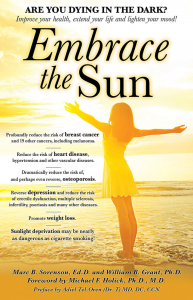
Happy sunning!
[1] Hoel D, de Gruijl, F. Sun Exposure Public Health Directives. Int. J. Environ. Res. Public Health 2018;15:2794
[2] Sorenson, Marc, Grant, WB. Embrace the Sun. Sorenson, Publisher 2018. Available at Amazon.
[3] Kasey L. Morris, PhD; Frank M. Perna, EdD, PhD. Decision Tree Model vs Traditional Measures to Identify Patterns of Sun-Protective Behaviors and Sun Sensitivity Associated With Sunburn. JAMA Dermatol. Published online June 27, 2018.
[4] Elizabet saes da SILVA, Roberto TAVARES, Felipe da silva PAULITSCH, Linjie ZHANG. Eur J Dermatol 2018; 28(2): 186-201.



